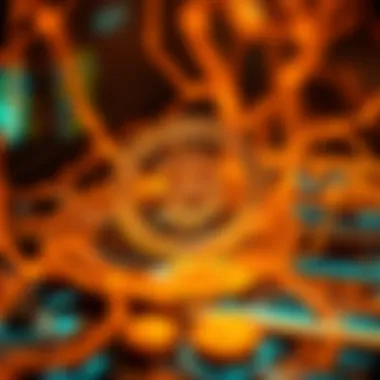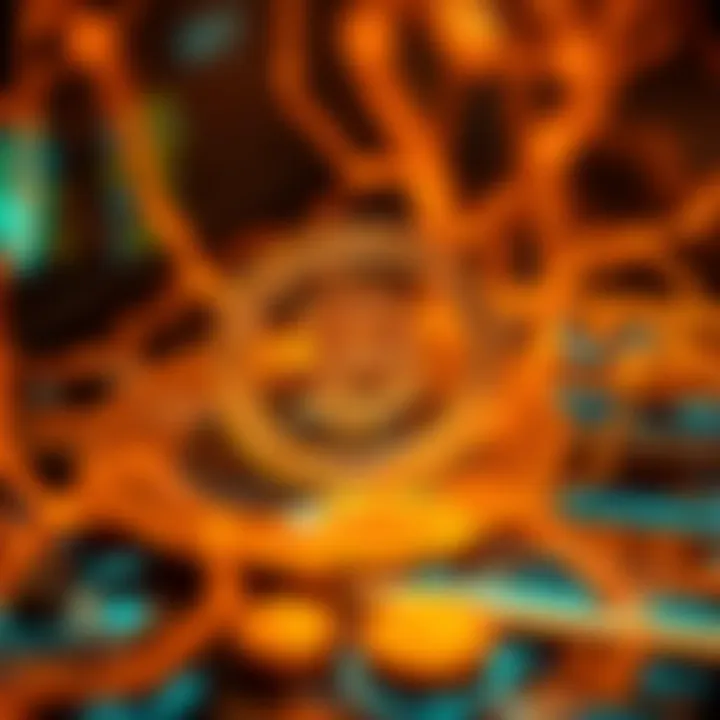Creating Non-Fungible Tokens in Cryptocurrency


Intro
In the evolving landscape of cryptocurrency, Non-Fungible Tokens (NFTs) have emerged as a groundbreaking innovation. Unlike cryptocurrencies such as Bitcoin, which are interchangeable, NFTs represent unique assets on the blockchain, allowing for verified ownership and provenance. As the digital economy continues to expand, understanding the mechanisms behind creating and managing NFTs can prove to be immensely beneficial.
This journey into the world of NFTs will shed light on what makes them tick—the technology that underpins them, the platforms that facilitate their creation, and the broader implications of ownership in digital formats. Whether you are an investor diving into an exciting market, an entrepreneur looking to create unique digital assets, or a developer aiming to build on these platforms, grasping the fundamentals will set the groundwork for deeper exploration.
Knowing the current trends and the technological advancements related to NFTs can provide significant insights. From fluctuating market valuations to the transformative power of blockchain technology, each element plays a vital role in the NFT ecosystem.
We will explore the intricacies of NFT creation, highlighting key aspects like market trends, technological innovations, and economic considerations, aimed specifically at savvy individuals seeking a comprehensive guide to navigate this complex terrain. Ultimately, our goal is to equip you with valuable knowledge for successful engagement in the NFT market.
Understanding Non-Fungible Tokens
In the world of digital assets, Non-Fungible Tokens (NFTs) have emerged as a pivotal development, reshaping ownership and representation in the crypto ecosystem. NFTs differ fundamentally from other digital currencies, providing unique identification tied to individual items. This uniqueness invites conversations about not only technological innovation but also the way we perceive art, music, and even moments in time. As the discourse surrounding NFTs continues to grow, understanding their essence becomes crucial for investors, analysts, entrepreneurs, and developers alike.
A key aspect of NFTs is their ability to offer verifiable ownership, thus instilling confidence in buyers. Unlike cryptocurrencies, which are interchangeable, NFTs are designed to signify distinct items, and their value often hinges on scarcity and provenance. With this in mind, some individuals view NFTs as a revolutionary form of art and collectibles, while others scrutinize their market behavior and sustainability.
In this section, we will dissect what Non-Fungible Tokens entail, focusing on their defining characteristics and the contrasts that separate them from traditional cryptocurrencies.
Definition and Characteristics
Non-Fungible Tokens are unique digital identifiers that are recorded on a blockchain, granting proof of ownership for a specific item, whether it's digital art, music, or even virtual real estate. Each NFT possesses distinct metadata and attributes that differentiate it from others, making it non-interchangeable – hence the term 'non-fungible.' Essentially, every NFT signifies something that cannot be swapped for another on a one-to-one basis, like a classic painting, versus a dollar bill which is interchangeable by virtue of its currency value.
The characteristics of NFTs include:
- Indivisibility: Unlike cryptocurrencies, NFTs cannot be divided into smaller units. Each token exists as a whole.
- Ownership Verification: The blockchain serves as an irrefutable ledger, ensuring that owners can prove possession easily.
- Scarcity: Creators have the ability to limit the number of NFTs for any given item, which can drive prices based on rarity.
- Programmability: Many NFTs can include smart contracts that dictate their resale conditions or royalty agreements for creators.
"NFTs represent ownership of unique items in a digital landscape, fundamentally changing how we perceive value and authenticity in the art world."
Differences between NFTs and Cryptocurrencies
It's essential to recognize how NFTs stand apart from cryptocurrencies. While both leverage blockchain technology, their applications and implications diverge significantly. Here are some notable distinctions:
- Interchangeability: Cryptocurrencies like Bitcoin are fungible, meaning each unit is the same as another and can be exchanged freely. NFTs are unique or limited edition, hence they are not interchangeable.
- Value Determination: The value of cryptocurrencies is often based on market supply and demand, while NFT value may also depend on artistic merit, creator reputation, and cultural significance of the item.
- Utility and Functionality: Cryptos usually function as currencies or stores of value, whereas NFTs can represent various kinds of assets, from artwork to domain names.
By understanding the nuances and parameters around Non-Fungible Tokens, one gains insight into their rapidly growing significance not only in finance but across creative industries and beyond.
The Technology Behind NFTs
Non-Fungible Tokens, or NFTs, are not just a trendy buzzword; they represent a seismic shift in how we perceive ownership and value in the digital realm. Understanding the technology behind NFTs is crucial for anyone looking to navigate the intricate landscape of the crypto ecosystem. At the core, NFTs are tied to two primary technological aspects: blockchain technology and smart contracts. These elements bring about unique benefits and considerations that are important for both creators and consumers.
Blockchain Fundamentals
The heart of all NFT transactions lies within blockchain technology. This decentralized system enables transparency, security, and traces ownership history for every token created. Think of blockchain as a digital ledger that everyone can access, yet no one can change. It’s like a neighborhood whiteboard where all community transactions are diligently noted; once something is written, it sticks around for anyone to see.
In the context of NFTs, each token is unique and exists on a specific blockchain. For instance, Ethereum stands out as the predominant blockchain for NFTs due to its advanced capabilities and wide acceptance. This allows artists and collectors to mint and trade tokens without worrying about a middleman hoarding the art or diluting the value. However, not all blockchains are created equal—some are more efficient or environmentally friendly than others. Here are a few things to consider when diving into blockchain technology for NFTs:
- Decentralization: Ownership is not tied to any single entity, making transparency a key feature.
- Security: Encrypted information provides a solid defense against hacking or fraud.
- Interoperability: Many platforms support multiple blockchains, increasing possibilities for creators and collectors alike.
Smart Contracts Explained
Smart contracts are pivotal in automating transactions and ensuring that the terms of agreements are executed when certain conditions are met. They operate similarly to vending machines, where you put in money and receive a product without needing a cashier. In the world of NFTs, smart contracts establish the rules for the token and enforce them without the need for intermediaries.
For instance, when an artist sells an NFT, a smart contract can automatically ensure they receive a percentage of any future sales, thus preserving long-term benefits. This self-executing feature not only fosters trust but also eliminates lengthy settlement processes. However, there are some nuances worth noting:
- Immutable: Once deployed, smart contracts often can't be changed, so it’s crucial to get it right the first time.
- Cost of Gas: Transactions may come with fees, often referred to as gas, especially on congested networks like Ethereum.
- Vulnerability to Bugs: If not coded carefully, smart contracts can have bugs that lead to exploitation.
"An NFT, when tied to a well-structured smart contract, can be a game-changer for artists, allowing them to maintain control and earn from their work in perpetuity."
For further insights, consider checking out resources from Wikipedia (Wikipedia - Blockchain) or Britannica - What are Smart Contracts? for supplementary information.
Choosing the Right Blockchain for NFTs
Selecting the appropriate blockchain for creating Non-Fungible Tokens (NFTs) is paramount in the process of entering the crypto ecosystem. This decision can significantly influence the success and functionality of your NFTs. Each blockchain offers unique benefits and drawbacks, and understanding these factors can lead you to a more informed choice that aligns with your goals as a creator.
Ethereum as the Leading Platform
Ethereum is often regarded as the kingpin of NFT creation. Launched in 2015, it quickly became a favorite among artists, game developers, and entrepreneurs for its robust features and vast ecosystem. The main reason Ethereum stands out is its established infrastructure. It allows users to create NFTs using the ERC-721 and ERC-1155 standards, which are widely recognized by marketplaces like OpenSea and Rarible.


Moreover, Ethereum provides a solid backing through a vast community. This means ongoing support, constant improvements, and a plethora of resources for creators. The following key points highlight Ethereum’s merit:
- Trust and Security: The proof-of-work model has been time-tested, ensuring a secure environment for transactions.
- Large User Base: A big community ensures liquidity and better exposure for your NFTs.
- Interoperability: NFTs created on Ethereum can easily interact with various platforms and wallets.
However, it's not without its challenges. The high transaction costs (gas fees) can deter some creators, especially those starting out. Plus, the potential for slow transaction speeds during peak times may frustrate users. Nevertheless, many still regard Ethereum as the premier choice for serious NFT projects.
Emerging Alternatives: Flow, Tezos, and Others
While Ethereum has pioneered the space, emerging blockchains are gaining traction and offering compelling alternatives for NFT creators. Here are a few notable players:
- Flow: Developed by Dapper Labs, Flow is designed specifically for NFTs. It boasts lower transaction costs and higher speeds, making it an attractive option for creators. Platforms like NBA Top Shot leverage Flow’s technology, showing its robustness.
- Tezos: Tezos is known for its eco-friendly approach, using a proof-of-stake consensus which minimizes environmental impact. It features smart contracts and allows easy NFT minting while being less congested than Ethereum.
- Polygon: A layer-2 solution for Ethereum, Polygon allows for faster transactions at lower costs, making it a hybrid choice. Artists can mint seamlessly without the heavy fees attached to the Ethereum mainnet.
Emerging blockchains offer distinct advantages, such as cost-efficiency and environmental consideration. Yet, their ecosystems may lack the depth and traction that Ethereum possesses.
"Choosing the right blockchain for NFTs is like picking the right canvas for your masterpiece; it can shape how your art is perceived and valued."
In summary, determining the right blockchain involves weighing the advantages and disadvantages of each. Ethereum remains a leading force due to its established reputation and resources, while newer options like Flow and Tezos present innovative solutions catering to specific needs of creators. Considerations such as fees, speed, and community support can guide you towards making a choice that aligns with your NFT vision.
NFT Creation Platforms and Tools
In the world of NFTs, the platforms and tools that facilitate their creation are paramount. These platforms provide the necessary infrastructure for artists, creators, and entrepreneurs to mint their digital assets and share them with a burgeoning market. Choosing the right platform can be the difference between a successful NFT launch and a missed opportunity. Each platform comes with distinct features, fees, and functionalities that can cater to specific needs or preferences.
Overview of Popular Platforms
Diving into popular NFT platforms reveals a diverse ecosystem, each with its own flair:
- OpenSea: Considered one of the largest NFT marketplaces, OpenSea allows users to create, sell, and discover NFTs across various categories. Its user-friendly interface and extensive reach make it a go-to option for many.
- Rarible: This community-driven platform not only lets artists mint their NFTs but also provides users the ability to create decentralized governance through its own token, RARI. Rarible is perfect for independent artists looking to significantly engage with viewers while monetizing their art.
- Mintable: This platform focuses on ease of use and encourages new creators. Mintable simplifies the process, offering both a free and a paid version, allowing creators to mint NFTs with just a few clicks. It's particularly appealing for those not deeply versed in blockchain technology.
- Foundation: Positioned as an invite-only platform, Foundation aims to create a curated space for creators. Artists gain access through invitations from existing members, which can foster a community of high-quality digital art.
- Zora: This platform emphasizes creator autonomy and offers tools for sales along with the ability to mint NFTs. Zora’s approach is more decentralized, encouraging creators to create a sustainable income stream through their art.
Each of these platforms has its unique selling points, and understanding their strengths and weaknesses is essential for a successful NFT venture.
Step-by-Step Guide on Creating an NFT
Creating an NFT might sound daunting, but breaking it down makes the process much simpler. Here’s a step-by-step guide to mint your own non-fungible token:
Step 1: Choose Your Artwork
This first stage is all about creativity. Select the artwork or digital asset you wish to convert into an NFT. Remember, it could be anything from a digital painting, a music file, or even a tweet.
Step 2: Selecting a Blockchain
Next, decide on the blockchain that aligns with your needs. Ethereum is the most popular, but alternatives like Flow and Binance Smart Chain have their merits. Consider fees, security, and community support as deciding factors.
Step 3: Pick an NFT Creation Platform
After deciding on the artwork and blockchain, choose a platform from the ones mentioned earlier. This selection often hinges on fees, user interface, and the community associated with the platform. It can also tie into the market that platform has access to.
Step 4: Set Up a Wallet
To create an NFT, you'll need a digital wallet capable of storing the NFTs and any cryptocurrency necessary for transaction fees. Platforms like MetaMask are widely used for this purpose.
Step 5: Mint Your NFT
Now, you are ready to mint! On your chosen platform, upload your artwork and fill in necessary details like title, description, and royalties. The royalties can be particularly strategic, allowing you to earn a percentage on future sales.
Step 6: List Your NFT for Sale
Once minted, it's time to put your NFT on the market. Depending on the platform, there will be options for setting fixed prices or auction styles. Make your pricing strategy clear and attractive to potential buyers.
Step 7: Market Your NFT
Consider promoting your NFT on social media, relevant crypto forums, and within creator communities to maximize visibility. Using platforms like Twitter and Reddit can significantly aid in gaining traction.
Creating an NFT is not merely a technical endeavor but an intermingling of art, technology, and commerce. By following these steps thoughtfully, potential creators can navigate this landscape with more confidence.
"The NFT space is a brave new world, but armed with the right tools, anyone can make their mark."
For more information on specific platforms or to view examples, consider checking out Wikipedia or various forums like Reddit for discussions and insights on market dynamics.


Design Considerations for NFTs
When venturing into the world of Non-Fungible Tokens, particularly from a creator's perspective, the design phase is crucial. It isn’t just about slapping a digital image into a smart contract; it involves a blend of artistry, strategic planning, and market awareness. Creativity must meet functionality to ensure the NFT is not only appealing but also widely accepted.
Artistic Elements and Metadata
Artistic elements play a foundational role in the success of an NFT. It's not merely about creating something visually striking; it encompasses the whole aesthetic experience. Digital art, music files, video clips, and virtual objects must resonate with potential buyers. Understanding the audience and what they value can guide the creator in crafting work that holds significance. Artists must consider the following aspects:
- Visual Appeal: The aesthetics must draw viewers in, creating an emotional connection. Sound design, color choices, and composition can make or break an NFT.
- Narrative: Every piece should tell a story. Does it reflect a trend, express emotions, or convey a message? A strong narrative engages buyers and can invoke higher eagerness for ownership.
- Cultural Relevance: Incorporating elements that resonate with current cultural or societal conversations can bolster interest and marketplace viability.
Aside from artistic values, the metadata of NFTs is equally important. It includes crucial information about the asset, such as the creator's details, transaction history, and potentially, the rights associated with the token. Properly structured metadata not only helps in establishing authenticity but also enhances visibility across platforms. Essentially, clean and richly detailed metadata ensures the right people can discover your work.
Ensuring Uniqueness and Scarcity
In the digital age, uniqueness is king; however, achieving depth beyond just a visually unique piece involves creating genuine scarcity. Not all NFTs are created equal; the more rare a token is, often the more value it commands. Here are some key points to consider in ensuring uniqueness and scarcity:
- Limited Editions: Offer a select number of tokens for each piece created. This captures the essence of exclusivity and can drive value significantly. Consider creating a series with limited release schedules.
- Smart Contract Capabilities: Utilize smart contracts to enforce the scarcity. This means coding in limits on how many copies can exist, or deploying certain functionalities where tokens could provide more than just digital ownership (like access to future content or events).
- Personal Touch: By embedding individual signatures or exclusive benefits into each token, creators can elevate the perceived value, ensuring collectors feel they own a part of the artist's legacy.
By crafting an NFT that emphasizes its unique identity and integrates scarcity into its creation, artists can position their work favorably in a competitive digital marketplace, enhancing the chance for success in an ever-evolving ecosystem.
Legal and Copyright Issues
As the world of Non-Fungible Tokens (NFTs) continues to evolve, navigating the complex landscape of legal and copyright issues is essential. This section will delve into how the legal domain intersects with NFTs, giving creators, buyers, and sellers a clear perspective on ownership rights and the regulatory landscape that governs these digital assets.
Understanding the implications of legal standards is vital because it not only influences how NFTs are created but also defines the very notions of ownership and originality in the digital space. The balance of creativity and legality ensures that artists can protect their work and that buyers are aware of what they are purchasing. The intricacies come into sharp focus when considering the implications on both local and global scales, given the borderless nature of cryptocurrencies.
Understanding Ownership Rights
Owning an NFT might seem straightforward at a glance—buy a digital artwork, and now you own that piece, right? However, the reality is often more complicated. Ownership in the NFT realm doesn’t automatically confer rights beyond possession of the token itself.
When someone purchases an NFT, they obtain the rights outlined in the smart contract attached to the token. Commonly, this simply means they have bought a certificate of authenticity verified on the blockchain, indicating they own a unique version of a digital file. Yet, the original artist typically retains other rights, such as reproduction, distribution, or the ability to create derivative works. This situation can lead to misunderstandings if not clearly communicated.
It’s crucial for buyers to check what rights they’re acquiring and for creators to explicitly list these rights in the associated documentation. This clarity protects both parties and limits potential disputes down the line. For instance:
- Full Ownership: The buyer can resell and display the work without restrictions.
- Limited Rights: The buying party can display the artwork but cannot license it or create derivatives.
- No Ownership Rights: The buyer simply owns the NFT but has no further rights to use the content in any manner.
"In the world of NFTs, knowing what you truly own can be the difference between being an art collector and just a spectator."
Navigating Licensing and Copyright Laws
When it comes to the realm of digital art and NFTs, licensing is more than just a legal formality; it determines how a creator’s work can be used, thereby affecting its market value. Many NFT creators might not be familiar with copyright laws, which can add layers of complexity.
Licensing deals can vary dramatically, so it is important for creators to think carefully about what permissions they are granting. For example, if an artist mint an NFT that includes their artwork, they should distinguish whether they’re giving the buyer a license to make copies, use the work for commercial purposes, or display it publicly.
Creators should consider utilizing a Creative Commons license or drafting a custom licensing agreement. Here are some tips:
- Clearly Define Terms: Detail what is allowed and what isn’t—this can save headaches later.
- Include Royalties: Smart contracts can be used to set up automatic royalties on secondary sales, ensuring artists continue to earn from their work.
- Consult Legal Experts: Given the ever-evolving nature of digital law, it’s wise to consult with legal experts familiar with the NFT space.
The legal aspect of NFTs is never a set-and-forget type of deal; it requires continuous learning and awareness of changes in laws and standard practices. By staying informed, both creators and buyers can enjoy the robust potential of NFTs while minimizing risks.
For further reading on copyright issues surrounding digital assets, you might explore resources like Wikipedia or dive into Britannica.
Overall, understanding the legal framework surrounding NFTs helps maintain a vibrant and fair market, allowing creativity and innovation to flourish.
Marketplaces for Buying and Selling NFTs
Marketplaces for buying and selling NFTs represent the heartbeat of the NFT ecosystem. They serve as the foundational platforms that connect creators, collectors, and investors. In this digital bazaar, the transaction of unique digital assets occurs, allowing individuals to buy and sell anything from digital art, music, and collectibles to virtual real estate and beyond. Understanding the intricacies of these marketplaces is not merely of interest; it's essential for anyone looking to engage seriously in the NFT realm.
A marketplace must curate a user-friendly and secure environment. This means that factors such as transaction fees, user interface, and community trust are pivotal. When diving into NFTs, investors and creators need platforms that promote not only ease of access but also provide adequate tools and support for transactions. Moreover, each marketplace often has its unique community and focus, whether that be generative art, gaming assets, or virtual fashion.
Leading NFT Marketplaces Overview
Several leading NFT marketplaces have emerged, each carving out a niche in the sprawling landscape:
- OpenSea: As one of the largest NFT marketplaces, OpenSea offers an extensive range of digital assets. It provides streamlined functionality, allowing users to browse and purchase NFTs with minimal hassle. Its vast selection includes everything from art to domain names, making it a popular choice for newcomers and seasoned collectors alike.
- Rarible: Rarible is community-centric and allows users to mint NFTs easily, giving it an edge for artists and creators looking to showcase their work. The platform also has its native governance token, RARI, which enables users to vote on platform upgrades and changes, fostering a sense of community ownership.
- Foundation: Focused heavily on the art community, Foundation is a selective platform that emphasizes high-quality digital art. Artists need to be invited to list their works, which helps in maintaining an exclusive environment that appeals to serious collectors.
- SuperRare: Like Foundation, SuperRare aims at serious art collectors. It allows artists to tokenize their unique works. Each piece is verified on the blockchain, ensuring authenticity and provenance, which adds an extra layer of value.
- NFT Gateway: This platform combines the worlds of NFT creation and trading. It allows users to mint their NFTs directly from the marketplace, integrating art tools and management features that cater to creators.
These marketplaces vary significantly in terms of user experience, offerings, and community culture. There’s no one-size-fits-all choice; careful consideration of what each platform specializes in is vital to finding the right fit.


Strategies for Pricing and Selling NFTs
Setting the right price for your NFTs and developing a selling strategy can feel like trying to hit a moving target. Understanding market demand, awareness of your unique value proposition, and tracking similar sales are essential strategies:
- Research Market Trends: Regularly monitor what other creators are charging for similar types of NFTs. Tools like DappRadar can provide insights into sales history, average prices, and trending assets.
- Consider Rarity and Utility: NFTs with unique attributes can command higher prices. Limited editions or unique traits can elevate perceived value. Similarly, if the NFT has a use case, like granting access to exclusive content or events, this can enhance pricing.
- Test Pricing: Don’t hesitate to experiment with your pricing. Listing your NFT at different price points initially can help gauge interest and determine a sweet spot for both buyers and sellers.
- Leverage Community and Social Media: Building a presence on platforms like Twitter, Discord, or Reddit can raise awareness for your collections. Engaging with potential buyers and participating in community discussions can build enthusiasm around your work, increasing the chances of sale.
- Highlighting Uniqueness in Descriptions: When listing your NFTs, emphasize what makes them valuable. Detailed descriptions can keep buyers engaged, informing them about the inspiration behind the work, the creative process, and the NFT’s unique characteristics.
By blending awareness of market tendencies with a flexible pricing strategy and leveraging community engagement, creators can maximize their chances for successful sales in an ever-evolving NFT landscape.
In the competitive world of NFTs, adaptability is key. Stay informed, be ready to pivot, and never underestimate the power of a well-crafted narrative around your digital assets.
Economic Implications of NFTs
The rise of Non-Fungible Tokens (NFTs) has stirred a significant discussion around their economic impact, intertwining art, technology, and finance into a complex tapestry. Understanding the importance of NFTs in the economic landscape is tantamount to grasping not just the technology but what it heralds for creators and collectors. The one-of-a-kind nature of NFTs creates opportunities and challenges across markets, pushing boundaries and redefining value propositions. They are not merely digital assets; they are changing the rules of engagement for traditional markets and shaping the economic behaviors of a new generation.
Impact on Traditional Art and Collectibles Market
NFTs have injected a fresh breath of life into the traditional art and collectibles market. Creative professionals and collectors alike are now recognizing the potential of digital ownership through NFTs. Unlike sitting in a gallery or scrolling through a physical merchandise catalog, artists can now present their work directly to an audience no matter where they are. This democratization of access has disrupted traditional gatekeeping mechanisms that once required an artist to seek approval from galleries or dealers.
- New Revenue Streams: With NFTs, artists can receive royalties every time their work is resold, creating a continuous revenue stream that was previously unattainable in the conventional art market. The phrase “what goes around comes around” fits here, as artists benefit from the ongoing life of their work.
- Global Reach: The digital nature of NFTs allows artworks and collectibles to transcend geographical limitations, reaching global audiences instantaneously. An artist in a small town can have their work valued and bought by a collector halfway across the world, something that was quite challenging in the past.
- Shift in Valuation: The introduction of NFTs has prompted new forms of valuation, where social and emotional connections arguably play a more crucial role than mere aesthetics. Art that has social significance can command higher prices, creating new economic pathways and cultural conversations around value.
However, this newfound freedom comes with decisions to navigate. Artists must grapple with questions about authenticity and permanence in a medium that is inherently mutable and replicable. The concept of ownership in a digital context is altered fundamentally, which can lead to economic fragmentation within traditional spaces as they attempt to adapt and accommodate this disruption.
Investment Opportunities and Risks
The NFT market has opened new doors for investors, unleashing a string of investment opportunities that are both exciting and fraught with risks. The financial potential of NFTs has intrigued both seasoned investors and novices looking to dip their toes into the crypto waters, but entering this territory requires a careful approach.
- Potential Gains: NFT investments can yield substantial returns. High-profile sales, such as Beeple's "Everydays: The First 5000 Days," which sold for a staggering $69 million, underscore the lucrative possibilities of investing in one-of-a-kind digital assets. Many view this as a modern gold rush, potentially yielding life-changing profits for informed investors.
- Volatility Risks: The market's volatility can’t be overstated. Prices may surge, but they can just as easily plummet, leaving investors with valuable assets that may not appreciate as anticipated. It’s crucial to look before you leap, as trends can shift overnight, often influenced by social media hype or market sentiments.
- Due Diligence: As with any investment, it's essential to perform due diligence. Understanding the creator’s reputation, the rarity of the digital item, and the platform where it's sold are paramount. In the world of NFTs, context is as important as content. As the saying goes, “don’t put all your eggs in one basket”; diversifying your NFT investments is key.
"The future transactions of art, music, real estate and much more could be conducted through smart contracts, which are triggered by the ownership of NFTs."
Investors must keep abreast of the rapidly evolving regulations regarding NFTs to mitigate potential legal risks. As governmental bodies across the world begin to grapple with the implications of digital ownership, staying informed can serve as a guide to navigating this dynamic landscape.
Future Trends in the NFT Landscape
As the world of NFTs continues to evolve, understanding these future trends is crucial for anyone involved in the crypto ecosystem. The landscape is shifting and growing, influencing various sectors beyond just art and collectibles. It’s a vital time for innovators, investors, and creators to keep their eyes peeled on upcoming advancements, as they can significantly alter how we perceive value and interaction in the digital space.
Technological Innovations
The technological advancements surrounding NFTs are nothing short of astounding. We see new applications emerging regularly that could reshape the way we create, trade, and utilize these digital assets. With improvements in blockchain technology, transaction speeds are on the rise, allowing for more seamless user experiences. Moreover, Layer 2 solutions like Polygon are making transactions more cost-effective, addressing prior concerns about high fees, particularly on Ethereum.
"Technological improvements offer not just efficiency, but also introduce greater possibilities within the NFT space, pushing boundaries we once thought unbreakable."
In addition, developments in augmented reality (AR) and virtual reality (VR) are providing innovative ways to present and interact with NFTs. Imagine not just owning digital art but being able to walk through it in a metaverse setting. These technological shifts not only enhance the appeal of NFTs but also open doors for brands and creators to engage their audiences in unique ways.
Furthermore, advancements in artificial intelligence can significantly enhance the creation of NFTs, leading to dynamic and interactive pieces that evolve based on user interactions or other variables. This convergence of technologies suggests that NFTs could become more than static images or simple tokens; they could morph into intelligent assets that react and adapt based on data inputs, creating a multi-dimensional engagement.
Cultural and Social Shifts
Culturally, NFTs are starting to change how we think about ownership and creativity. Traditionally, art and collectibles have been bound by physical forms and ownership rights, encapsulated in museums or private collections. With NFTs, we are witnessing a shift where digital creators gain recognition and a foothold in an economy that previously overlooked them. Artists, musicians, and other creators are harnessing the power of NFTs to connect directly with their audiences, bypassing old gatekeepers.
This democratization brings along profound societal implications, challenging our notions of value, scarcity, and authenticity. The rise of social tokens and community-driven projects illustrates this shift; individuals can invest not just in an asset but in communities and creators, fostering a more collaborative environment.
Moreover, encouraging real-world applications of NFTs, such as in the form of ticketing, event access, and loyalty rewards programs, further solidifies their position in modern culture. We're seeing concert tickets being sold as NFTs, enabling artists to retain a more significant share of their earnings and create unique experiences for fans.
As we navigate this rapidly shifting landscape, it’s essential to remain adaptable and aware of the nuances impacting NFT trends. By doing so, stakeholders can harness new opportunities while addressing the array of challenges presented in this ever-evolving space.
For further reading, you can explore resources like Wikipedia on NFTs or visit Investopedia for a more detailed understanding of the implications of these advancements.
Epilogue: Navigating the NFT Ecosystem
As we draw the curtain on the multifaceted landscape of Non-Fungible Tokens, it's imperative to acknowledge the deeper currents that drive this ever-evolving ecosystem. Navigating the NFT ecosystem might seem like sailing through murky waters for novices, but with the right insights and strategies, it can transform into an exciting voyage. This conclusion isn't just a summary; it's a pivotal moment to reflect on the intricacies of ideas, tools, and broader implications that NFTs bring to the table.
Key Takeaways
- Understanding Ownership: At its core, the NFT phenomenon hinges on ownership rights. Creators must grasp how ownership is defined and protected in the digital realm. This goes beyond just being the maker of a piece; it’s about knowing how to claim rights and navigate the potential legal labyrinth.
- Market Dynamics: The market for NFTs is a swirling cacophony of desire and speculation. Buyers tend to fuel this ecosystem with their willingness to invest in what they perceive as unique or rare. Being attuned to trends and shifts is crucial for anyone looking to enter or thrive within this space.
- Tech Foundations: The technology supporting NFTs—be it smart contracts or blockchain—needs to be more than a footnote in a creator's journey. Familiarity with these tech basics not only empowers creators but also fosters trust among buyers.
- Expand Your Horizons: The NFT landscape is not static. There are emerging platforms like Flow and Tezos alongside giants like Ethereum, and each comes with its own capabilities and communities. Understanding these differences can present new opportunities for creation and collaboration.
Next Steps for Potential Creators
For those looking to dip their toes into the waters of NFT creation, consider the following actionable steps:
- Research Your Potential Market: Take time to understand existing art, collectibles, and digital assets within your intended niche. Gaining insights into what's popular or what gaps exist in the market can guide your creative strategy.
- Select the Right Tools: Explore different platforms such as OpenSea, Rarible, or Mintable to find which aligns best with your needs and design comfort. Experimenting with various tools will help you ascertain the one that truly resonates with your artistic vision.
- Understand Legal Contexts: Think about copyright implications. It may be wise to consult legal experts to ensure that your creations are both original and compliant with existing laws.
- Join Communities: Immerse yourself in NFT-focused forums, Discord servers, and social media channels. Engaging with other creators and collectors can provide invaluable insights and support throughout your journey.
- Iterate and Evolve: Keep refining your approach. Listen to feedback from your audience and adapt your strategies accordingly. The NFT world is one that rewards innovation and adaptability.
"The future belongs to those who believe in the beauty of their dreams." - Eleanor Roosevelt



